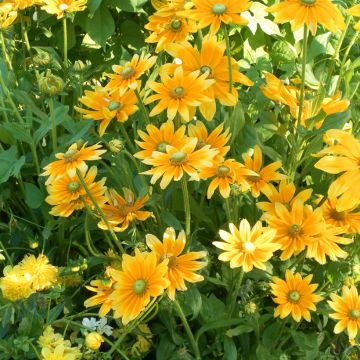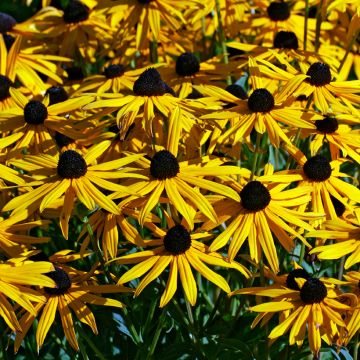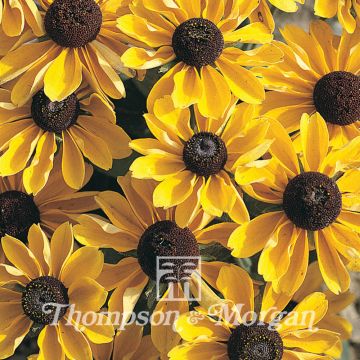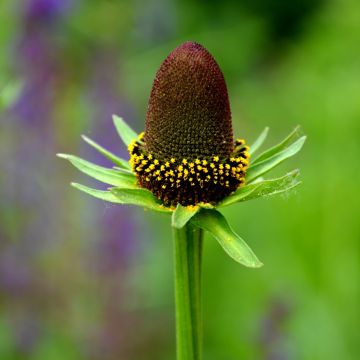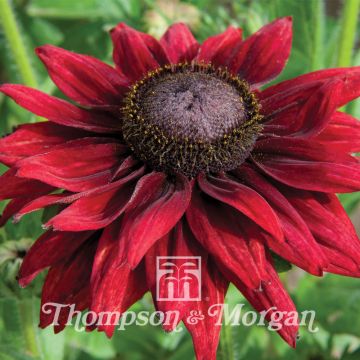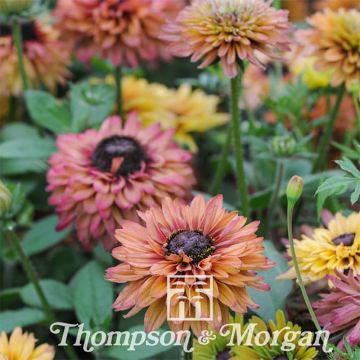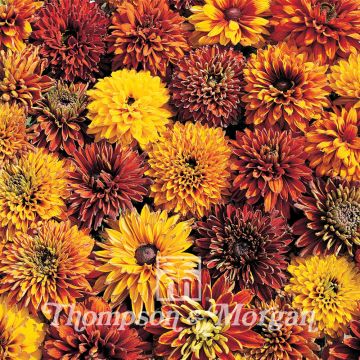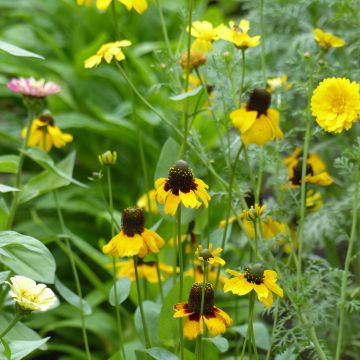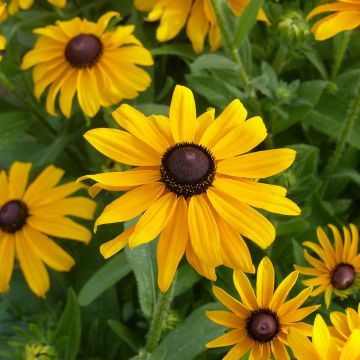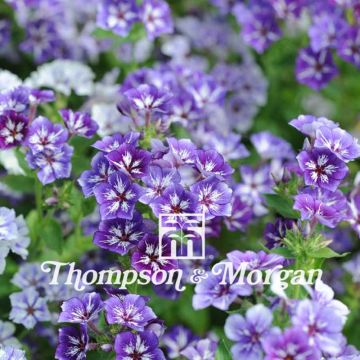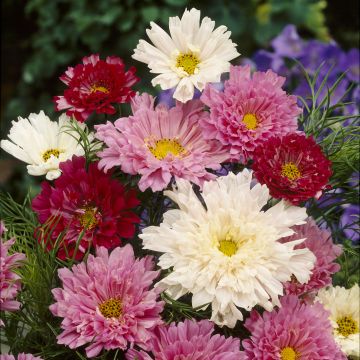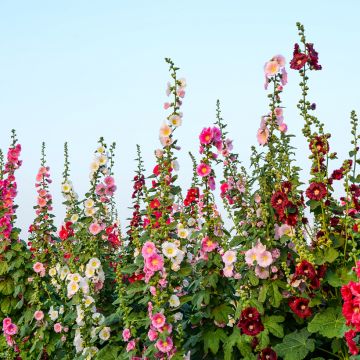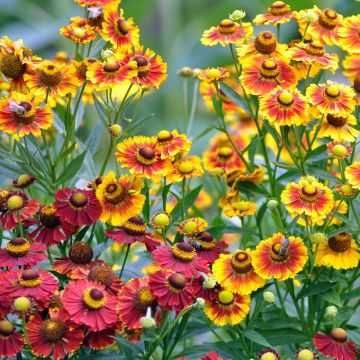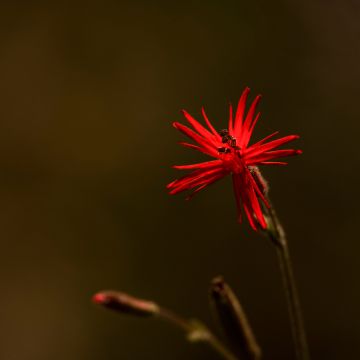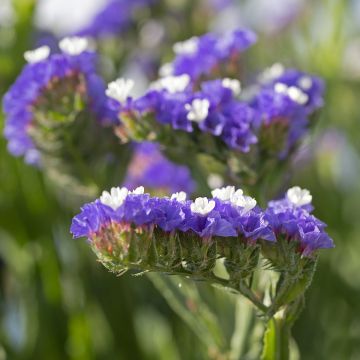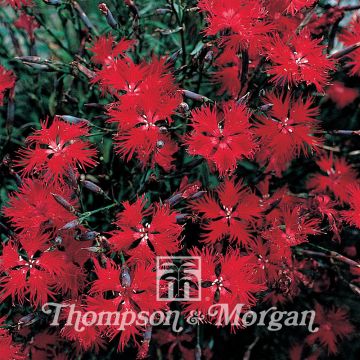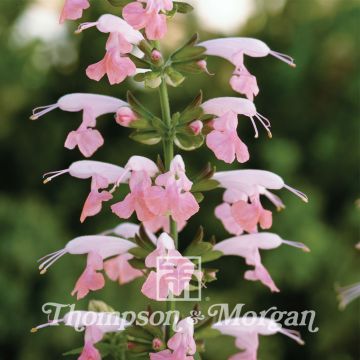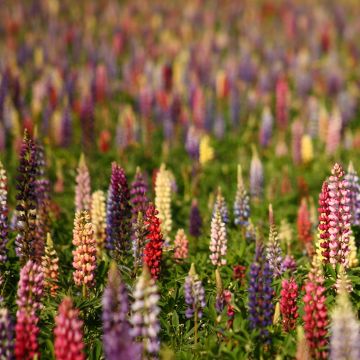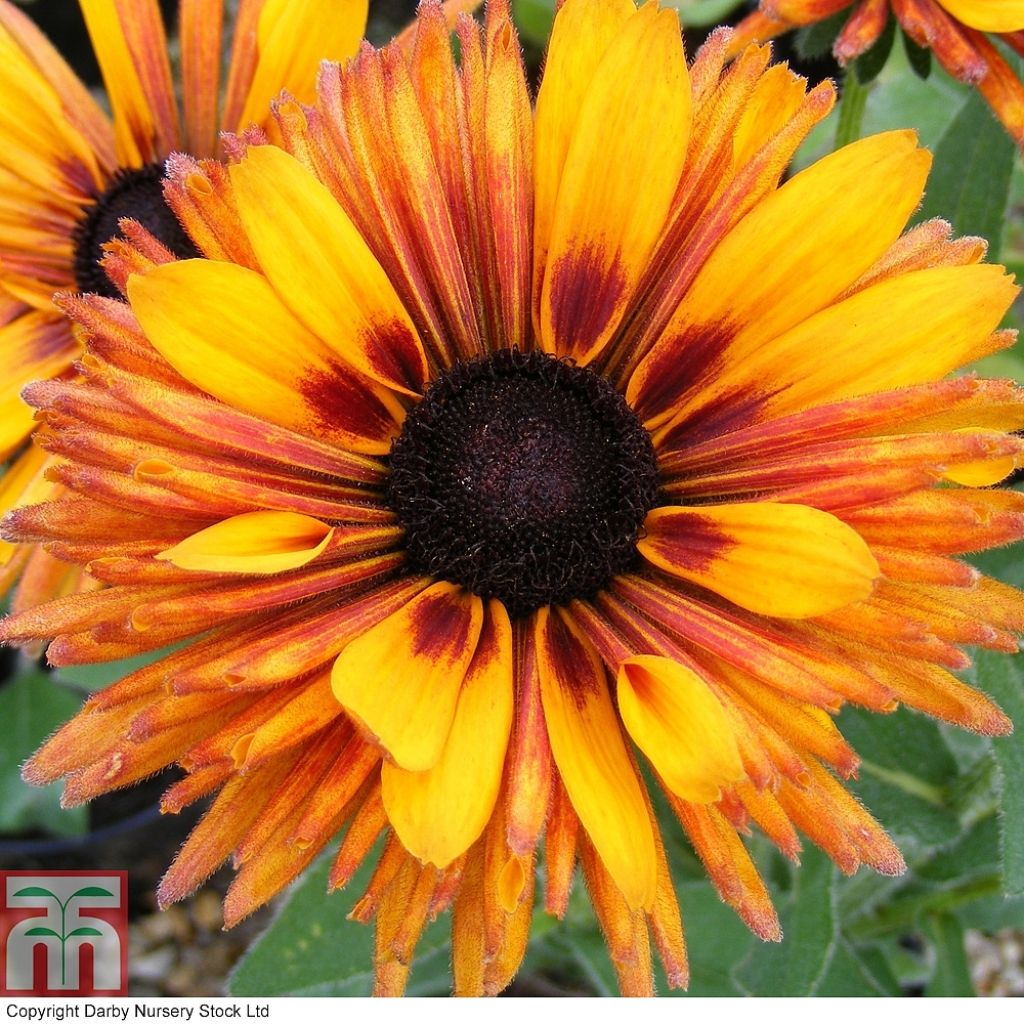

Rudbeckia hirta Chim Chiminee
Rudbeckia hirta Chim Chiminee
Rudbeckia x hirta Chim Chiminee
Black-eyed Susan, Gloriosa Daisy, Yellow Ox-eye Daisy
All the seeds that were sown have germinated successfully. The young plants continue to grow. Transplanting will be happening soon! Thank you!
Tatsiana, 27/04/2019
This item cannot be shipped to the selected country
Dispatch by letter from €3.90
More information
Schedule delivery date,
and select date in basket
This plant carries a 6 months recovery warranty
More information
We guarantee the quality of our plants for a full growing cycle, and will replace at our expense any plant that fails to recover under normal climatic and planting conditions.
Seed-only orders are dispatched by sealed envelope. The delivery charge for seed-only orders is €3.90.
Does this plant fit my garden?
Set up your Plantfit profile →
Description
The Rudbeckia x hirta from the 'Chim Chiminee mix stands out for the unusual appearance of its large flowers, which are single or sometimes double daisies with narrow and fringed petals. A sleek line enhanced by warm colours that are easy on the eyes: banana yellow, golden yellow, copper orange, muted red, bronze, and mahogany. The spectacle of this flowering lasts all summer, until the first frost, on sturdy plants that will make a big impression in borders, beds, and flower pots. Indifferent to heat and poor soils, these short-lived perennial plants also thrive in sunny or semi-shaded positions.
The Rudbeckia x hirta from the 'Chim Chiminee' selection are recent cultivars resulting, among others, from the Rudbeckia hirta, a robust wild plant from the Asteraceae family native to the prairies of North America. It is a short-lived perennial plant often grown as an annual or biennial plant. Indeed, in the garden, it will not last more than 2 to 3 years, but it readily self-seeds. The 'Chim Chiminee' variety, shorter than its ancestor, reaches a height of 45 to 60 cm (18 to 24in) depending on the plants and spreads about 40 cm (16in).
The inflorescences of this Rudbeckia are large 'daisies', actually solitary head-like inflorescences, with a diameter of 7 to 10 cm (3 to 4in), centred on a prominent dark brown cone. Many flowers succeed each other from July to October on the plants, forming an impressive multicoloured mass. At the end of summer, the petals fade and fall while the flowers' centre dries and shrivels. The flowers can then be picked and incorporated into a dried bouquet. The foliage consists of a tuft of basal lanceolate, dentate leaves, dark green, 5 to 10 cm (2 to 4in) long, from which sturdy and branched floral stems rise. The stems bear cauline leaves, narrower and somewhat ovate.
The Rudbeckia 'Chim Chiminee' stout silhouette allows them to fit into perennial beds, borders, and large flower pots. They can be paired with other varieties or combined with inulas, asters, yarrows, daisies, echinops... You can also lighten the scene by mixing ornamental grasses such as Stipa tenuifolia and Muhlenbergia capillaris... Their rich colours are gorgeous in beds and fresh or dried flower arrangements. Hardy, Rudbeckia hirta thrives in sunny or semi-shaded positions and doesn't mind the soil; it is a particularly heat-resistant plant that tolerates dry and poor soils.
An ecological asset: Throughout summer, the nectar-rich flowers of Rudbeckias attract pollinating insects and butterflies. An excellent way to improve your garden's ecosystem and promote fruit and vegetable production in your vegetable patch. In autumn, you can admire the continuous ballet of birds that come to feed on the mature seeds they find in the heart of the dried flowers.
Report an error about the product description
Flowering
Foliage
Plant habit
Botanical data
Rudbeckia
x hirta
Chim Chiminee
Asteraceae
Black-eyed Susan, Gloriosa Daisy, Yellow Ox-eye Daisy
Cultivar or hybrid
Other Rudbeckia seeds
Planting and care
Before sowing the rudbeckia, place your seeds in the vegetable compartment of your refrigerator for 4 weeks. This will break the seed's dormancy and improve your sowing's success.
Sow the seeds from February to April in a seed tray. Use a good quality compost that you will sieve on the surface to bind the seed to its substrate. Before sowing, gently press down the compost with a board. Sow your seeds by broadcasting. Cover the seeds by sprinkling compost on top or using vermiculite, gently press down and water generously with a fine rain. Place your seed tray in a well-lit area, without direct sunlight, at a temperature of 20°C (68°F) to 25°C (77°F). Lower the temperature at night to 18°C (64.4°F) to create a beneficial alternation for germination.
The seeds will germinate in 10 to 21 days. When the seedlings are manageable, transplant them into 7cm (3in) pots. Keep the compost moist but not excessively during growth. Then, 15 days before their final planting, start gradually acclimating them to a temperature of 15°C (59°F).
By the end of May or early June, the temperature in the garden will be warm enough to plant your young plants. Choose a sunny location. Add a good shovel of compost to each planting hole. Space your plants 30 cm (12in) apart.
Regularly remove faded flowers to maintain their beauty and promote repeat flowering.
Sowing period
Intended location
-
, onOrder confirmed
Reply from on Promesse de fleurs
Flower seeds
Haven't found what you were looking for?
Hardiness is the lowest winter temperature a plant can endure without suffering serious damage or even dying. However, hardiness is affected by location (a sheltered area, such as a patio), protection (winter cover) and soil type (hardiness is improved by well-drained soil).

Photo Sharing Terms & Conditions
In order to encourage gardeners to interact and share their experiences, Promesse de fleurs offers various media enabling content to be uploaded onto its Site - in particular via the ‘Photo sharing’ module.
The User agrees to refrain from:
- Posting any content that is illegal, prejudicial, insulting, racist, inciteful to hatred, revisionist, contrary to public decency, that infringes on privacy or on the privacy rights of third parties, in particular the publicity rights of persons and goods, intellectual property rights, or the right to privacy.
- Submitting content on behalf of a third party;
- Impersonate the identity of a third party and/or publish any personal information about a third party;
In general, the User undertakes to refrain from any unethical behaviour.
All Content (in particular text, comments, files, images, photos, videos, creative works, etc.), which may be subject to property or intellectual property rights, image or other private rights, shall remain the property of the User, subject to the limited rights granted by the terms of the licence granted by Promesse de fleurs as stated below. Users are at liberty to publish or not to publish such Content on the Site, notably via the ‘Photo Sharing’ facility, and accept that this Content shall be made public and freely accessible, notably on the Internet.
Users further acknowledge, undertake to have ,and guarantee that they hold all necessary rights and permissions to publish such material on the Site, in particular with regard to the legislation in force pertaining to any privacy, property, intellectual property, image, or contractual rights, or rights of any other nature. By publishing such Content on the Site, Users acknowledge accepting full liability as publishers of the Content within the meaning of the law, and grant Promesse de fleurs, free of charge, an inclusive, worldwide licence for the said Content for the entire duration of its publication, including all reproduction, representation, up/downloading, displaying, performing, transmission, and storage rights.
Users also grant permission for their name to be linked to the Content and accept that this link may not always be made available.
By engaging in posting material, Users consent to their Content becoming automatically accessible on the Internet, in particular on other sites and/or blogs and/or web pages of the Promesse de fleurs site, including in particular social pages and the Promesse de fleurs catalogue.
Users may secure the removal of entrusted content free of charge by issuing a simple request via our contact form.
The flowering period indicated on our website applies to countries and regions located in USDA zone 8 (France, the United Kingdom, Ireland, the Netherlands, etc.)
It will vary according to where you live:
- In zones 9 to 10 (Italy, Spain, Greece, etc.), flowering will occur about 2 to 4 weeks earlier.
- In zones 6 to 7 (Germany, Poland, Slovenia, and lower mountainous regions), flowering will be delayed by 2 to 3 weeks.
- In zone 5 (Central Europe, Scandinavia), blooming will be delayed by 3 to 5 weeks.
In temperate climates, pruning of spring-flowering shrubs (forsythia, spireas, etc.) should be done just after flowering.
Pruning of summer-flowering shrubs (Indian Lilac, Perovskia, etc.) can be done in winter or spring.
In cold regions as well as with frost-sensitive plants, avoid pruning too early when severe frosts may still occur.
The planting period indicated on our website applies to countries and regions located in USDA zone 8 (France, United Kingdom, Ireland, Netherlands).
It will vary according to where you live:
- In Mediterranean zones (Marseille, Madrid, Milan, etc.), autumn and winter are the best planting periods.
- In continental zones (Strasbourg, Munich, Vienna, etc.), delay planting by 2 to 3 weeks in spring and bring it forward by 2 to 4 weeks in autumn.
- In mountainous regions (the Alps, Pyrenees, Carpathians, etc.), it is best to plant in late spring (May-June) or late summer (August-September).
The harvesting period indicated on our website applies to countries and regions in USDA zone 8 (France, England, Ireland, the Netherlands).
In colder areas (Scandinavia, Poland, Austria...) fruit and vegetable harvests are likely to be delayed by 3-4 weeks.
In warmer areas (Italy, Spain, Greece, etc.), harvesting will probably take place earlier, depending on weather conditions.
The sowing periods indicated on our website apply to countries and regions within USDA Zone 8 (France, UK, Ireland, Netherlands).
In colder areas (Scandinavia, Poland, Austria...), delay any outdoor sowing by 3-4 weeks, or sow under glass.
In warmer climes (Italy, Spain, Greece, etc.), bring outdoor sowing forward by a few weeks.

































